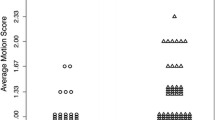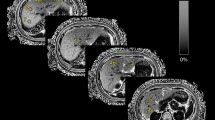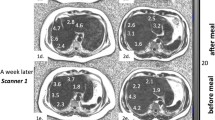Abstract
Purpose
Determine intra- and inter-examination repeatability of magnitude-based magnetic resonance imaging (MRI-M), complex-based magnetic resonance imaging (MRI-C), and magnetic resonance spectroscopy (MRS) at 3T for estimating hepatic proton density fat fraction (PDFF), and using MRS as a reference, confirm MRI-M and MRI-C accuracy.
Methods
Twenty-nine overweight and obese pediatric (n = 20) and adult (n = 9) subjects (23 male, 6 female) underwent three same-day 3T MR examinations. In each examination MRI-M, MRI-C, and single-voxel MRS were acquired three times. For each MRI acquisition, hepatic PDFF was estimated at the MRS voxel location. Intra- and inter-examination repeatability were assessed by computing standard deviations (SDs) and intra-class correlation coefficients (ICCs). Aggregate SD was computed for each method as the square root of the average of first repeat variances. MRI-M and MRI-C PDFF estimation accuracy was assessed using linear regression with MRS as a reference.
Results
For MRI-M, MRI-C, and MRS acquisitions, respectively, mean intra-examination SDs were 0.25%, 0.42%, and 0.49%; mean intra-examination ICCs were 0.999, 0.997, and 0.995; mean inter-examination SDs were 0.42%, 0.45%, and 0.46%; and inter-examination ICCs were 0.995, 0.992, and 0.990. Aggregate SD for each method was <0.9%. Using MRS as a reference, regression slope, intercept, average bias, and R 2, respectively, for MRI-M were 0.99%, 1.73%, 1.61%, and 0.986, and for MRI-C were 0.96%, 0.43%, 0.40%, and 0.991.
Conclusion
MRI-M, MRI-C, and MRS showed high intra- and inter-examination hepatic PDFF estimation repeatability in overweight and obese subjects. Longitudinal hepatic PDFF change >1.8% (twice the maximum aggregate SD) may represent real change rather than measurement imprecision. Further research is needed to assess whether examinations performed on different days or with different MR technologists affect repeatability of MRS voxel placement and MRS-based PDFF measurements.



Similar content being viewed by others
References
Reeder SB, Cruite I, Hamilton G, Sirlin CB (2011) Quantitative assessment of liver fat with magnetic resonance imaging and spectroscopy. J Magn Reson Imaging 34:729–749. doi:10.1002/jmri.22775
Reeder SB, Sirlin CB (2010) Quantification of liver fat with magnetic resonance imaging. Magn Reson Imaging Clin N Am 18:337–357, ix. doi:10.1016/j.mric.2010.08.013
Permutt Z, Le TA, Peterson MR, et al. (2012) Correlation between liver histology and novel magnetic resonance imaging in adult patients with non-alcoholic fatty liver disease. Aliment Pharmacol Ther 36:22–29. doi:10.1111/j.1365-2036.2012.05121
Le TA, Chen J, Changchein C, et al. (2012) Effect of colesevelam on liver fat quantified by magnetic resonance in nonalcoholic steatohepatitis: a randomized controlled trial. Hepatology 56:922–932. doi:10.1002/hep.25731
Thomsen C, Becker U, Winkler K, et al. (1994) Quantification of liver fat using magnetic resonance spectroscopy. Magn Reson Imaging 12:487–495
Johnson NA, Walton DW, Sachinwalla T, et al. (2008) Noninvasive assessment of hepatic lipid composition: advancing understanding and management of fatty liver disorders. Hepatology 47:1513–1523. doi:10.1002/hep.22220
Meisamy S, Hines CD, Hamilton G, et al. (2011) Quantification of hepatic steatosis with T1-independent, T2-corrected MR imaging with spectral modeling of fat: blinded comparison with MR spectroscopy. Radiology 258:767–775. doi:10.1148/radiol.10100708
Yokoo T, Bydder M, Hamilton G, et al. (2009) Nonalcoholic fatty liver disease: diagnostic and fat-grading accuracy of low-flip-angle multiecho gradient-recalled-echo MR imaging at 1.5 T. Radiology 251:67–76. doi:10.1148/radiol.2511080666
Yokoo T, Shiehmorteza M, Hamilton G, et al. (2011) Estimation of hepatic proton-density fat fraction by using MR imaging at 3.0 T. Radiology 258:749–759. doi:10.1148/radiol.10100659
Yu H, McKenzie CA, Shimakawa A, et al. (2007) Multiecho reconstruction for simultaneous water-fat decomposition and T2* estimation. J Magn Reson Imaging 26:1153–1161. doi:10.1002/jmri.21090
Yu H, Shimakawa A, McKenzie CA, et al. (2008) Multiecho water-fat separation and simultaneous R2* estimation with multifrequency fat spectrum modeling. Magn Reson Med 60:1122–1134. doi:10.1002/mrm.21737
Artz NS, Haufe WM, Hooker CA, et al. (2015) Reproducibility of MR-based liver fat quantification across field strength: same-day comparison between 1.5T and 3T in obese subjects. J Magn Reson Imaging 42:811–817. doi:10.1002/jmri.24842
Guaraldi G, Besutti G, Stentarelli C, et al. (2012) Magnetic resonance for quantitative assessment of liver steatosis: a new potential tool to monitor antiretroviral-drug-related toxicities. Antivir Ther 17:965–971. doi:10.3851/IMP2228
Johnson BL, Schroeder ME, Wolfson T, et al. (2014) Effect of flip angle on the accuracy and repeatability of hepatic proton density fat fraction estimation by complex data-based, T1-independent, T2*-corrected, spectrum-modeled MRI. J Magn Reson Imaging 39:440–447. doi:10.1002/jmri.24153
Kang GH, Cruite I, Shiehmorteza M, et al. (2011) Reproducibility of MRI-determined proton density fat fraction across two different MR scanner platforms. J Magn Reson Imaging 34:928–934. doi:10.1002/jmri.22701
Kuhn JP, Hernando D, Mensel B, et al. (2014) Quantitative chemical shift-encoded MRI is an accurate method to quantify hepatic steatosis. J Magn Reson Imaging 39:1494–1501. doi:10.1002/jmri.24289
Ligabue G, Besutti G, Scaglioni R, Stentarelli C, Guaraldi G (2013) MR quantitative biomarkers of non-alcoholic fatty liver disease: technical evolutions and future trends. Quant Imaging Med Surg 3:192–195. doi:10.3978/j.issn.2223-4292.2013.08.01
Mashhood A, Railkar R, Yokoo T, et al. (2013) Reproducibility of hepatic fat fraction measurement by magnetic resonance imaging. J Magn Reson Imaging 37:1359–1370. doi:10.1002/jmri.23928
Reeder SB, Robson PM, Yu H, et al. (2009) Quantification of hepatic steatosis with MRI: the effects of accurate fat spectral modeling. J Magn Reson Imaging 29:1332–1339. doi:10.1002/jmri.21751
Tang A, Tan J, Sun M, et al. (2013) Nonalcoholic fatty liver disease: MR imaging of liver proton density fat fraction to assess hepatic steatosis. Radiology 267:422–431. doi:10.1148/radiol.12120896
Negrete LM, Middleton MS, Clark L, et al. (2014) Inter-examination precision of magnitude-based MRI for estimation of segmental hepatic proton density fat fraction in obese subjects. J Magn Reson Imaging 39:1265–1271. doi:10.1002/jmri.24284
US Department of Health and Human Services (2015) Analytical Procedures and Methods Validation for Drugs and Biologics: Guidance for Industry. Food and Drug Administration CDER & CBER. http://www.fda.gov/downloads/drugs/guidancecomplianceregulatoryinformation/guidances/ucm386366.pdf. Accessed 23 Dec 2014
Hines CD, Frydrychowicz A, Hamilton G, et al. (2011) T(1) independent, T(2) (*) corrected chemical shift based fat-water separation with multi-peak fat spectral modeling is an accurate and precise measure of hepatic steatosis. J Magn Reson Imaging 33:873–881. doi:10.1002/jmri.22514
Liu CY, McKenzie CA, Yu H, Reeder SB (2007) Fat quantification with IDEAL gradient echo imaging: correction of bias from T(1) and noise. Magn Reson Med 58:354–364. doi:10.1002/mrm.21301
Hernando D, Hines CD, Yu H, Reeder SB (2012) Addressing phase errors in fat-water imaging using a mixed magnitude/complex fitting method. Magn Reson Med 67:638–644. doi:10.1002/mrm.23044
Noureddin M, Lam J, Peterson MR, et al. (2013) Utility of magnetic resonance imaging versus histology for quantifying changes in liver fat in nonalcoholic fatty liver disease trials. Hepatology 58:1930–1940. doi:10.1002/hep.26455
Hamilton G, Middleton MS, Bydder M, et al. (2009) Effect of PRESS and STEAM sequences on magnetic resonance spectroscopic liver fat quantification. J Magn Reson Imaging 30:145–152. doi:10.1002/nbm.1622
Hamilton G, Yokoo T, Bydder M, et al. (2011) In vivo characterization of the liver fat 1H MR spectrum. NMR Biomed 24:784–790. doi:10.1002/jmri.21809
Naressi A, Couturier C, Devos JM, et al. (2001) Java-based graphical user interface for MRUI, a software package for quantitation of in vivo/medical magnetic resonance spectroscopy signals. Comput Biol Med 31:269–286
Vanhamme L, van den Boogaart A, Van Huffel S (1997) Improved method for accurate and efficient quantification of MRS data with use of prior knowledge. J Magn Reson 129:35–43
Acknowledgments
Contract grant sponsor: National Institutes of Health; Contract grant numbers: NIDDK R01 DK075128, NIDDK R01 DK088925, NCMHD EXPORT P60 MD00220, NIH T32 EB005970, UL1TR000100.
Author information
Authors and Affiliations
Corresponding author
Electronic supplementary material
Below is the link to the electronic supplementary material.
Rights and permissions
About this article
Cite this article
Tyagi, A., Yeganeh, O., Levin, Y. et al. Intra- and inter-examination repeatability of magnetic resonance spectroscopy, magnitude-based MRI, and complex-based MRI for estimation of hepatic proton density fat fraction in overweight and obese children and adults. Abdom Imaging 40, 3070–3077 (2015). https://doi.org/10.1007/s00261-015-0542-5
Published:
Issue Date:
DOI: https://doi.org/10.1007/s00261-015-0542-5




